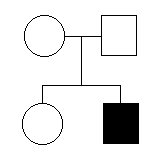As
has been stressed in class, when one is trying to understand a new topic it
helps to look at it in different ways, from different points of view. In
whatever way you first encounter the topic, whether hearing about it in class
or reading about it in the textbook, there is a tendency to remember it that
way. However, the same topic (concept, material) may appear in other ways
when you see it again. If you've seen it only one way, thought about it only
one way, you may not recognize it or see how it applies in the new
setting. This touches on the distinction between
"memorization" and "understanding." The questions
here may help you to determine whether you're understanding cell division.
Question #1
ANSWER (wrestle with it first)
Question #2 (Do Question #1 first; #2 is meant to be compared to #1).
The symbols in Question #1 represent entire chromosomes, and homology is
represented by a pair of symbols of the same size and shape with one
cross-hatched but the other not. Suppose instead that we were interested
in three specific loci, each on a different homologous chromosome pair.
The genotype in Question #1 might then be represented as shown in this drawing,
using symbols such as we used in working problems in class. If this cell
undergoes meiosis, what are all of the gamete genotypes possible? (Note
that this is the same as question #1- but using different symbols.)
 ANSWER
ANSWER
In #2 above the organism was heterozygous for each of the 3 loci. This
time we're interested in following the same 3 loci through meiosis in an
individual whose genotype is shown below. What are the gamete genotypes
possible from this individual?
ANSWER
Here are 3 different loci in the parental genotype. If we assume that no crossing over occurs, what are all of the gamete genotypes possible?
As we did in class, let's assume that in the pedigree below the allele of
interest that the son in this family expresses is one of these:
autosomal dominant OR autosomal recessive OR sex-linked dominant OR sex-linked
recessive. Perform an analysis as we did in class to determine
which of the four this is.

ANSWER: autosomal dominant? autosomal recessive? sex-linked dominant? sex-linked recessive? Conclusion?
Suppose that you're studying microscope slides of meiosis in a plant species
and that one slide shows that there are 12 tetrads.
a. Which stage(s) of meiosis are you looking at? ANSWER
b. What is the diploid chromosome number of this species? ANSWER
Go back to question #4. Let's allow crossing over to occur between the two linked loci. Does that change the outcomes? That is, what are all of the possible gamete genotypes produced by this parental genotype now? ANSWER
And don't overlook the obvious in
your studying. That is, do you know the
vocabulary (word meanings and facts)?
For example:
Can you define synapsis, segregation, assortment, crossing over, sister
chromatids? Do you know the difference
between homologous chromosomes and sister chromatids? Do you know when the important events
occur during mitosis and/or meiosis? Do
you really
know the differences between mitosis and meiosis? These are only a few of the obvious things
one should know from the cell division material covered in class. Then there's the vocabulary about inheritance
material and the genetic code material.